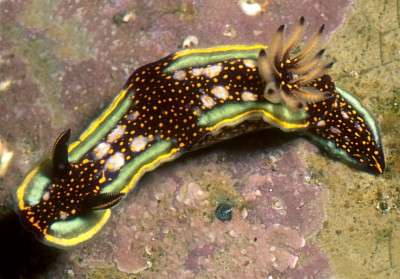
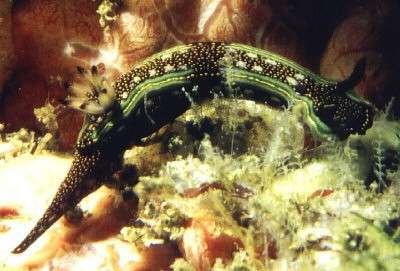
Hypselodoris agassizii
(Bergh, 1894)
Order: NUDIBRANCHIA
Suborder: DORIDINA
Superfamily: EUDORIDOIDEA
Family: Chromodorididae
DISTRIBUTION
East Pacific from Galapagos Ids, Costa Rica, Panama, Mexico.
PHOTO
UPPER: Costa Rica, East Pacific Coast, January 2000. PHOTO: T.Gosliner.
LOWER: Costa Rica, April 1994, 13m depth. PHOTO: H.-H. Harms.
See messages below.
Reference:
• Bergh, R. (1894) Reports on the dredging operations off the West Coast of Central America to the Galapagos, to the West Coast of Mexico, and in the Gulf of California, in charge of Alexander Agassiz, carried on by the U.S. Fish Commission Steamer "Albatross", during 1891, Lieut. Commander Z.L.Tanner, U.S.N., Commanding. XIII. Die Opisthobranchien. Bulletin of the Museum of Comparative Zoology 25(10): 125-233.
Rudman, W.B., 2000 (February 22) Hypselodoris agassizii (Bergh, 1894). [In] Sea Slug Forum. Australian Museum, Sydney. Available from http://www.seaslugforum.net/find/hypsagas
Related messages
A comment on giant slugs
August 5, 2003
From: Alicia Hermosillo
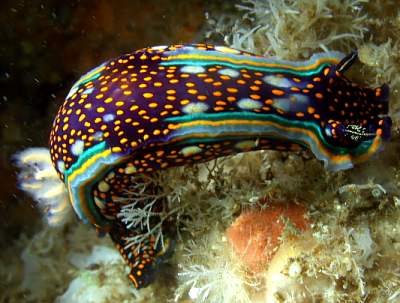

Dear Dr. Rudman,
I thought very interesting the message of the giant Tylodina perversa. As you correctly mention, in few occasions all of us come about true giants for the species.
This guy I am sending, besides showing a brighter coloration than usual for this species, Hypselodoris agassizii, it was a true giant, over 10 cm long. (Islas Marietas, Bahia de Banderas), June 6th, 2003.
For a specimen this big and chubby, it could be it was parasitised very young by a copepod (or something related) that damaged the gonads. So when the animal does not use any of its energy in growing gonads and reproducing, uses it to grow. I did not want to collect and dissect him and prove this since I figured he had suffered enough already.
Ali
gueri25@hotmail.com
Hermosillo, A., 2003 (Aug 5) A comment on giant slugs. [Message in] Sea Slug Forum. Australian Museum, Sydney. Available from http://www.seaslugforum.net/find/10644Dear Ali,
Being rendered infertile by a parasite is an interesting, if unhappy, idea. I hope next time you find a giant you are feeling a little less kind, and can test your hypothesis by having a look inside. It is also interesting how the background colour of the animal can look quite different in colour in your two photos.
Best wishes,
Bill Rudman
Hypselodoris agassizii is from Mexico
March 26, 2002
From: Alicia Hermosillo
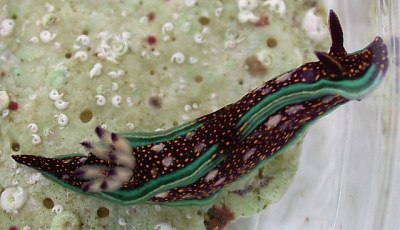
Dear Bill,
Here is a better picture of Hypselodoris agassizii. It is from Islas Marietas, north part of Bahía de Banderas, Mexico, collected at 25 feet and is 12 mm long [Pacific coast].
Dr Gosliner's posting comparing H. agassizii and Chromodoris sphoni is very interesting. Actually, there are 2 other species which bear the black, the blue-green line at the margin, the light colored distally black branchial plumes and dark lamellate rinophores.
I have sent separate messages of these 2 species, Mexichromis antonii, Mexichromis tura, and also of Chromodoris sphoni, for comparison.
Alicia Hermosillo
alicia_titan@infosel.net.mx
Hermosillo, A. , 2002 (Mar 26) Hypselodoris agassizii is from Mexico. [Message in] Sea Slug Forum. Australian Museum, Sydney. Available from http://www.seaslugforum.net/find/6543Dear Ali,
Thanks for these interesting photos. Hopefully as your work progresses you will discover their food preferences, the shape of their egg ribbons and their type of embryonic development.
best wishes,
Bill Rudman
Hypselodoris agassizii from Mexico
March 22, 2002
From: Alicia Hermosillo
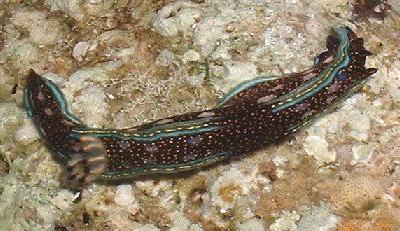
Dear Bill,
I have just begun my doctoral research project on the Ecology of the nudibranchs of Bahia de Banderas, on the Pacific coast of Mexico. I would like to share photos of some of the many species I hope to find in my study.
Here is a photo of Hypselodoris agassizii I found on the 24 February, at Los Arcos, Bahia de Banderas, which is my favourite spot.
It was found at about 50 feet next to the wall. In 3 dives we observed 31 individuals of 14 different species.
Locality data: Los Arcos, Bahia de Banderas, State of Jalisco and Nayarit, Mexico, 24 February, 2002.
Alicia Hermosillo
gueri25@hotmail.com
Hermosillo, A., 2002 (Mar 22) Hypselodoris agassizii from Mexico. [Message in] Sea Slug Forum. Australian Museum, Sydney. Available from http://www.seaslugforum.net/find/6498Thanks Alicia,
I have made a Summary Page, outlining your research project and I look forward to seeing more photos and information on your interesting fauna.
Best wishes,
Bill Rudman
Hypselodoris agassizii & Chr. sphoni
February 25, 2000
From: Terry Gosliner

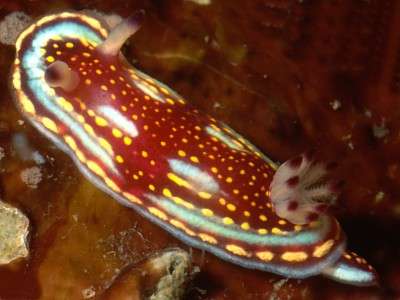
Dear Bill,
It was good to see the photo of Hypselodoris agassizii. Angel Valdes and I were in Costa Rica in January working with our colleague Yolanda Camacho at the National Institute of Biodiversity on the molluscan inventory project. We were able to collect material from localities along the southern Pacific coast. We saw many examples of H. agassizii. It is the only Hypselodoris that has interrupted marginal lines. What is interesting is that it has a similar color pattern to Chromodoris sphoni that is also commonly encountered in this part of the tropical eastern Pacific. I am enclosing another image of H. agassizi [UPPER] and one of C. sphoni [LOWER] for comparison.
Terry
tgosline@calacademy.org
Gosliner, T., 2000 (Feb 25) Hypselodoris agassizii & Chr. sphoni. [Message in] Sea Slug Forum. Australian Museum, Sydney. Available from http://www.seaslugforum.net/find/1961Thanks Terry,
Glad to hear your new job still allows you time out to do some malacology. I must say I had never seriously looked at this east Pacific group of similarly coloured chromodorids until I tried to identify Erwin Koehler's photo. Its remarkable how these two have both broken the marginal colour bands at the same place, and both have whitish gills with blackish tips. Doesn't Mexichromis tura also have a very similar pattern?
All the best,
Bill Rudman.
Hypselodoris agassizii from Costa Rica
February 23, 2000
From: Erwin Koehler

Dear Bill,
This one was made by H.-H. Harms in Costa Rica, East Pacific Coast in April 1994, 13m depth.
I think it looks like Hypselodoris lapislazuli (Bertsch & Ferreira, 1974) in Debelius...
Erwin
Medslugs.Koehler@t-online.de
Koehler, E., 2000 (Feb 23) Hypselodoris agassizii from Costa Rica. [Message in] Sea Slug Forum. Australian Museum, Sydney. Available from http://www.seaslugforum.net/find/1945Dear Erwin,
There are a group of similar looking east Pacific chromodorids and this photo does look a bit like H. lapislazuli. However my feeling is that it is a colour form of Hypselodoris agassizii. From published descriptions and Terry Gosliner's photo from Mexico on Mike Miller's site the animal in this photo does not have the distinct blue inner line at the border, or such bright yellow spots, but in general pattern it matches H. agassizii better than any of the other hypselodorids from that region. Other distinctive features are the translucent white gills with black tips and the break in the marginal coloured bands halfway along each side of the mantle.
Hopefully someone with a knowledge of that fauna can confirm this identification for me.
Best wishes,
Bill Rudman.
